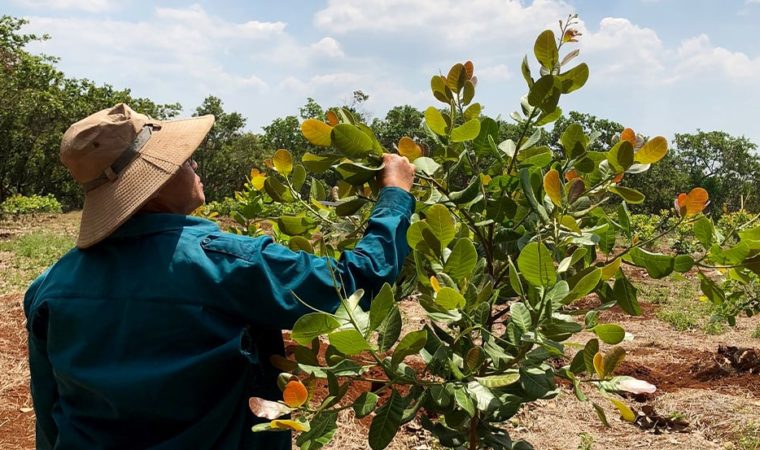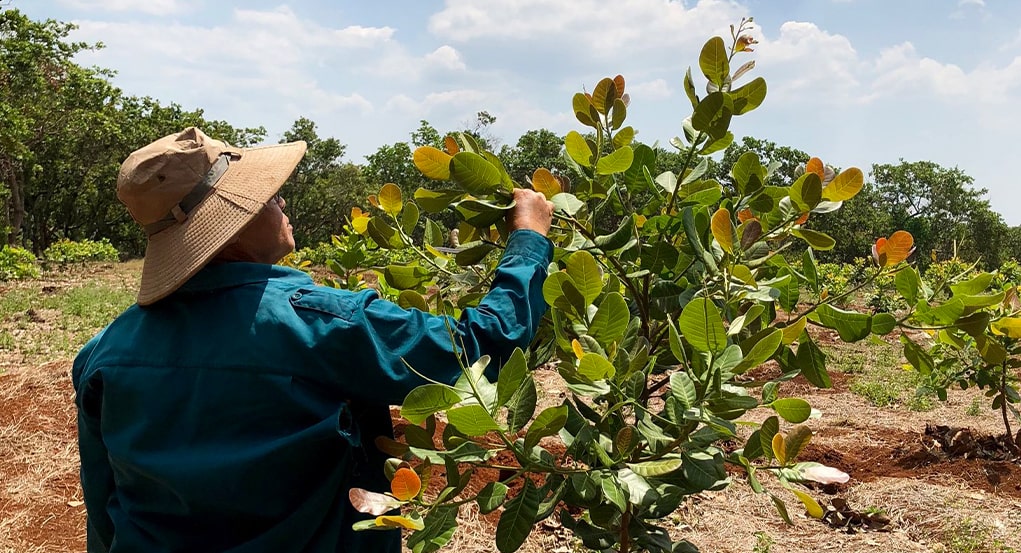



Part One – Maude’s story of the human aspect, to farming Vietnam’s largest export – The Cashew
Three places that seemingly couldn’t be more different from one another: a Northern California metropolis, a bone dry desert in the Coachella Valley, and a hot, humid, Southeast Asian jungle a world away. What binds these disparate places and people is one journey to trace our company’s flagship ingredient, the cashew, from our corporate headquarters in San Francisco and our factory in Indio, California, to the farms and processors in Vietnam.
We sent two members of our team to Vietnam, where the majority of our cashews are grown and processed, to gather as much information as possible about the environmental, social, and economic impacts of our cashews, and to better understand our cashew supply chain. Please enjoy Part 1 of a two-part series where Maude Manoukian, our Chief Community Officer, reflects on the people and cultural aspects of the cashew trade in Vietnam
Food is personal. Food is communal. Food is fundamental. I am reminded of these food truths daily as I answer consumer inquiries on all variety of topics. Every exchange has an element of intimacy and illuminates for me how food connects us. Ingredients, processing techniques, sourcing — people are interested and impacted by how food is grown, made, and shared.
At Forager Project, cashews are one of our core ingredients. Delicate and creamy, cashews are the foundation ingredient for many of our plant-based products, including our dairy-free milk and yogurt. We receive a lot of questions about the sourcing of this most important ingredient. Recently, I had the opportunity to travel to Vietnam to learn first-hand about the people, cultivation and processing of our cashews.
My body is burningly awake, fueled by the fatigue of being awake for more than a day and having watched too many in-flight movies. The discomfort of sitting in an airplane seat for nearly 30 hours is real! But, it is overwhelmed by the excitement I feel at the coming week.

Ho Chi Minh City – Population 8.6 Million
As soon as my cab exits the airport onto the road toward the hotel, we are nearly drowned in a sea of scooters driven by men, women and children of all ages and sizes. About thirty minutes later we emerge from the scootery-depths of Ho Chi Minh City traffic to arrive at my hotel which is located in District 1 of Ho Chi Minh City. After a quick shower and a brief hello to Carly, our Director of Innovation and my travel companion, I collapse in a heap. This is good news since we will head out bright and early the next morning for a farm visit.

Vietnam shares neighbors with China, Cambodia and Laos

Scooters for days! 45 million registered motorbikes in Vietnam!
We meet our hosts in the hotel lobby and pile into the van that will deliver us to the first of the farming cooperatives we are scheduled to visit. Located four-plus hours away very close to the Cambodian border, we slowly make our way through traffic and out of the city. As the minutes’ pass, the road becomes less dense and the roadside is lightly speckled with friendly stands that offer commuters respite from their travels with goodies like coconut water, beer and hammocks.
We wind our way through the countryside and find our destination off of a side road to a side road. The chief of the farming Co-op comes out to greet us. He is friendly and quick to smile. He reminds me of a treasured grandpa whose quiet way belies a mischievous nature. When we shake hands, I notice he is missing one of the fingers on his right hand. This is one of the few physical indicators of his former life as a local leader of the Viet Kong.
As we walk toward the farmhouse in front of us which looks to be part house and part meeting center, I hear the clamor and laughter of children coming from a little kitchen that is just off of the main meeting room. I see a few men hanging out with the kids, playing games and keeping them entertained. I learn from several of the people I meet that this scene is not uncommon. In many households, men have taken on the role of primary caretaker while the women are out earning money for the family. This shifted familial structure is just one of the cultural side effects of the war.
After some quick introductions, we head out to the orchard to wander through what appears to be more lightly groomed forest than a carefully planned agricultural system. We have to watch our step as large craters (reminders of the massive bombing the country endured) litter the ground around us. The depressions have been seamlessly integrated into the orchard and cashew trees are planted around, next to, and inside the numerous craters.
I am awed to find myself in such quiet vitality surrounded by these unassuming and friendly trees. It wasn’t even fifty years ago that the exact spot was a site of intense violence. As I weave through the trees, I come into step with the chief and our local host. Suddenly, I am overwhelmed with embarrassment and emotion as I feel the weight of the political history that ties us to one another.
But as I listen to the men talk, I am reminded that life doesn’t stop. These men both spent time in this area during the war, on opposite sides, seeking out a secret spot where they might be able to get a little sleep away from the main fighting areas. I am told that this cashew orchard was at the time a dense forest used by many soldiers to hide and rest. Although I still feel a strange guilt and discomfort, listening to their conversation reminds me that life and beauty can find a way even after such divide and devastation.

Cashew trees require no irrigation! Our supplier is the 2nd largest employer in the town, a true supporter of this rural, farming community.
We move away from the intensity of the moment as we move deeper into the orchard. They explain we are visiting prior to harvest, so field activity is pretty minimal and today there are only a few women out in the fields. Dressed in beautiful woven dresses the women are out “sweeping” the orchard floor clearing the ground around the trees so that when the cashew pods start to drop it will be easier to harvest them. They are engrossed in quiet conversation which seems to fit with the physical environment.
As we approach the women, we are greeted with warm smiles. They skillfully demonstrate for us how they separate the cashew pods from the apples. Once separated, the pods are placed into a basket with straps that they wear like backpacks. Once their baskets are full they will take the pods to a designated drying area and then head back to the orchard to fill their baskets again. The women seem relaxed and make the work look easy, but like most experts, this is an illusion that is really just a testament to their skill. The pace is very rhythmic and there is something soothing about the work.
One of the women, in particular, seems to radiate joy. She was working with her baby in a sling while her daughter who looks to be around five plays nearby. When the girl notices strangers have temporarily encroached on her vast playground, she runs to her mom to hide behind her, periodically peeking out so she can make her assessments.
When we visit the other farms, I see a clear pattern. Family seems to be a key factor in why and how work is chosen and done. I spoke with a woman who was very matter-of-fact in telling me she chose to farm cashews because it allowed her to maximize her time with her family. Because farming cashews require fewer inputs than many other agricultural crops, she has more time to be at home with her kids. Indeed, although she very kindly agreed to meet us at her orchard and answer all of our questions, she couldn’t quite hide her desire to get home.

Harvested by hand – Apple Cashews
At first glance, cashew processing seems like stepping into an entirely different world from the farms. The relaxed pace and tranquility of the cashew fields is a distant memory replaced by a noisier and much more deliberate clip. But, in fact, there are many parallels. Most importantly, food is inextricably linked with one’s family and community.
All of our factory visits start socially with tea, local fruit and, of course, cashews. Time is dedicated to giving us all a chance to talk and connect before diving into the business of how they process cashews and run the factory. Person after person shares their personal journey and how the work they do connects them to others.
One owner shares that he is driven to provide a place where family members and friends can go to work in a healthy environment providing healthy food for all to enjoy. Having grown up during the war, he is dedicated to making a positive and healthy impact on the world. His transition to organics fifteen years earlier was driven by this sense of responsibility.
Another factory manager confides that he is proud to be the second largest employer in the area. When I ask how increased mechanization has impacted his workforce, he explains, with more than a little passion, that no one is let go. As one part of his operation is mechanized, he moves people into other areas which allow his overall business to grow. He tells me he would not be able to hold his head up if he expanded his business at the expense of the people. He also shared his satisfaction that much of the automation on the line is on the shelling and splitting, which means the workers have even less chance of being exposed to the oils which are strong enough to burn the skin.
The processing teams appeared to have a quiet camaraderie. The focus required for detailed work like peeling, sorting and grading combined with the noise from the machinery doesn’t lend themselves to the same kind of bubbly conversation found in the fields. Still, I observe long rectangular work tables that allow coworkers to see each other and interact. Additionally, there are communal areas where people can eat, socialize and enjoy break time together. One of the factories had a large covered outdoor spot where people can sit and enjoy the fresh air or grab a yoga mat to stretch out.
Much like I found in the fields, all the people I met and observed represent a diverse array of personalities. Some quiet, some outgoing, some funny, some intense and some laid back—they were people. People who are integral to the products Forager Project offers, the food we make, and the community we hope to build.


Forager Project is a family-owned and operated organic food company, crafting plant-based foods in California since 2013.